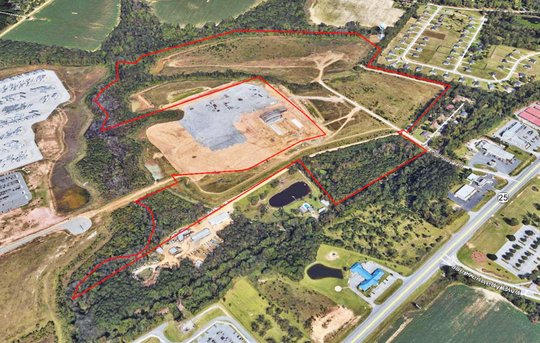Tensions run high at public meeting on fate of historic Georgia State University buildings
Tensions ran high at a town hall meeting May 28 as Georgia State University presented plans for a sweeping $107 million redevelopment project, drawing sharp criticism from residents concerned about the potential erasure of Atlanta’s historical landmarks. Dubbed “College Town Downtown,” the project will transform the Downtown GSU campus into a student-centered hub featuring green […] The post Tensions run high at public meeting on fate of historic Georgia State University buildings appeared first on Rough Draft Atlanta.


Tensions ran high at a town hall meeting May 28 as Georgia State University presented plans for a sweeping $107 million redevelopment project, drawing sharp criticism from residents concerned about the potential erasure of Atlanta’s historical landmarks.
Dubbed “College Town Downtown,” the project will transform the Downtown GSU campus into a student-centered hub featuring green spaces, safer walkways, new gathering areas, and an elevated plaza. University officials say the redesign will centralize campus activity, improve safety, and create a more engaging urban experience for students.
But for many Atlantans, the project comes with an unacceptable cost: the planned demolition of two historically significant buildings, Sparks Hall — built in 1955 and named after GSU’s first president — and century-old 148 Edgewood Ave., located in the Martin Luther King, Jr. Landmark District.
According to documents provided by GSU, 148 Edgewood would become a park, called the Fraternity and Sorority Life Plaza (FSL Plaza), providing students with “a larger dedicated greenspace for recreation and community-building while paying homage to Georgia State’s Greek life history as well as the history of the location.”
“Why tear down 148 Edgewood? Like, why?” demanded one woman during the public hearing. Her sentiment was echoed by other community members, who pleaded with university leaders to spare the structures.
“Tearing down a beautiful, historic, useful building is not being part of the city,” said another man at the meeting.
David Y. Mitchell, executive director of the Atlanta Preservation Center, urged GSU officials to reconsider.
“You don’t take books out of a library because they look old and different,” Mitchell said. “You leave them in so you have a full, rich understanding of who we are as a people and city.”
Atlanta City Councilmember and GSU graduate Liliana Bakhtiari said in a letter to the college that, “Preserving 148 Edgewood is not just about protecting a structure, it is about protecting the soul of a neighborhood and honoring the sacrifices and triumphs of those who came before us. Demolition would irreparably harm the integrity of the Landmark District and undermine efforts to create a more inclusive and historically aware Atlanta.”
Local attorney Alexander Heideman said 148 Edgewood, which was originally a Georgia Power electrical substation building, was “a testament to Atlanta’s industrial past and its evolution into a modern city. Its location on Edgewood Avenue, between Courtland Street and Piedmont Avenue, places it at the heart of a historically significant neighborhood that has witnessed Atlanta’s growth and the civil rights movement.”
While the university emphasizes safety and enhancing student experience as driving forces behind the project, preservationists and residents warn that eliminating these buildings would erase irreplaceable pieces of Atlanta’s cultural fabric.
“The argument to tear down a historic structure for a Greek green space, paying ‘homage’ to the razed building with a mural, is a weak rationale for demolition by neglect,” Georgia Tech Associate Professor of Architecture Danielle Willkens said in a letter to GSU.
The Georgia Trust for Historic Preservation, which added 148 Edgewood to its 2025 list of Georgia Places in Peril, also called the planned demolition “egregious.”
“Given the current condition of the building, and no publicly discernible efforts made by the University to consider adaptive use, a demolition of this historic resource would be particularly egregious,” Georgia Trust President W. Wright Mitchell said in a letter.
L. Jared Abramson, GSU’s Executive Vice President and Chief Operating Officer, defended the plan, emphasizing the need for concentrated, safe student spaces on the Downtown campus.
“We have hardly any green space in our Downtown, landlocked campus,” Abramson said. “What we have to do is create a safe place for our students by concentrating our activity instead of spreading ourselves thin.”
Abramson described the hub project as “a space where students can make it their own… bringing their good energy and creating a community.”
Kameron Wells, a recent GSU graduate and member of the Phi Beta Sigma fraternity, supported the plan to tear down 148 Edgewood, which is adjacent to Greek Housing facilities, and build the park.
He said fraternity and sororities on campus had been asking GSU for years to create a space where members could congregate. “The opportunities that this park will open up for the community will give us a cultural space to use,” Wells said.
University officials hope to complete the redevelopment ahead of the 2026 FIFA World Cup matches next summer.
Rough Draft reached out to GSU for details on how it would consider public comment and the letters received by residents and preservationists in its final decision on the buildings, but has not received a response.
Check back for updates.
The post Tensions run high at public meeting on fate of historic Georgia State University buildings appeared first on Rough Draft Atlanta.
What's Your Reaction?

























































